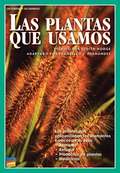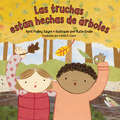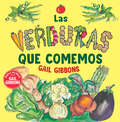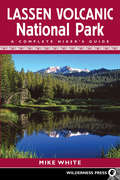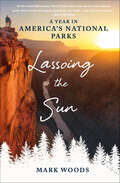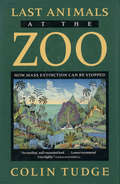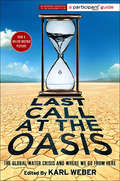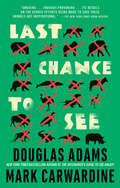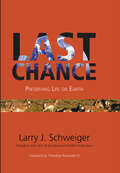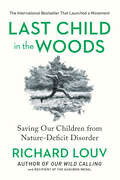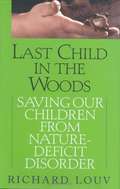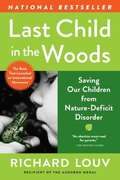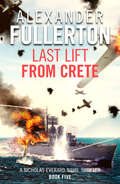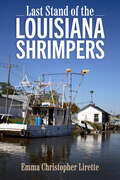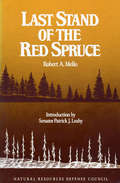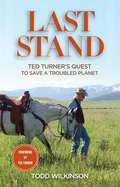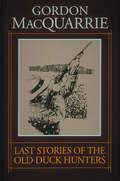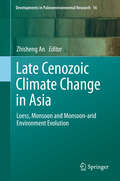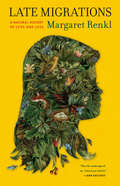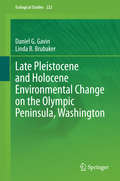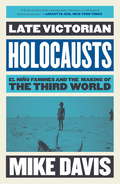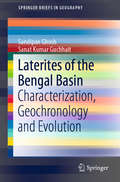- Table View
- List View
Las plantas necesitan agua (¡Arriba la Lectura!, Level K #43)
by Heather HammondsTanto los humanos como los animales dependen de las plantas para alimentarse. Por eso, es importante que las plantas reciban suficiente agua. ¿Cómo obtienen las plantas el agua que necesitan para sobrevivir? NIMAC-sourced textbook
Las plantas que usamos (Navigadores Series)
by Judith Hodge Francisco J. HernándezNIMAC-sourced textbook
Las plantas que usamos (¡Arriba la Lectura!, Level K #89)
by Lisa ShulmanNIMAC-sourced textbook. Las plantas se usan para hacer libros, ropa y muchas otras cosas. Descubre qué partes de las plantas se usan para hacer las cosas que necesitamos.
Las truchas están hechas de árboles
by April Pulley Sayre¡Las truchas realmente están hechas de árboles! Hojas y bacterias, insectos y peces, osos y personas; todos somos parte de un gran círculo de crecimiento, alimentación y vida –¡ahora en español!Trout are really made of trees! Leaves and bacteria, insects and fish, bears and people, too—we're all part of one big circle of growing and eating and living--now in Spanish!Un hábil matrimonio entre un texto lírico e ilustraciones de montaje energéticas, este libro explora las formas intrincadas y a menudo sorprendentes en las que las plantas y los animales están conectados en la cadena alimentaria; con texto final que describe los esfuerzos de conservación y el cuidado responsable.A deft marriage of lyrical text, and energetic collage illustrations, this book explores the intricate and often surprising ways plants and animals are connected in the food web, with back matter describing conservation efforts and responsible stewardship.
Las verduras que comemos
by Gail GibbonsWhat are vegetables, anyway? Find out the latest facts on 411 veggies in this illustrated introduction to produce, now available in Spanish!Peppers, beans, corn, and peas! Nonfiction superstar Gail Gibbons lays out the basics of veggies with colorful watercolors and straightforward text. This Spanish translation, derived from the new and updated edition, teaches Spanish vocabulary and fascinating facts about the veggies we eat. Readers will find out how they grow, how they get to stores, and how many kinds there are—and learn some weird trivia, too!Diagrams, cross-sections, and illustrations give kids an up-close view of glossy red peppers, plump orange pumpkins, delectable little peas, and dozens of other vegetables in this essential Spanish-language earth sciences primer.
Lassen Volcanic National Park
by Mike WhiteThe guide to the hikers' paradise of Lassen Volcanic National Park - with its still-active geologic wonders and view-packed summits - has been completely updated and expanded, with new trips, photos, and maps to complement the user-friendly design of the popular National Park series. Revamped by veteran author Mike White, this guide features 95 dayhike and backpack trips to popular sites such as Lassen Peak and Bumpass Hell, as well as little-known backcountry gems. Also included are trips into regions surrounding the Park, including the Hat Creek Recreation Area, greater Susanville-Chester area, Warner Valley, Butte Lake, and Drakesbad regions, McArthur-Burney Falls Memorial State Park, plus the Thousand Lakes, Caribou, Ishi, and Bucks Lake wilderness areas.
Lassoing the Sun: A Year in America's National Parks
by Mark Woods"In this remarkable journey, Mark Woods captures the essence of our National Parks: their serenity and majesty, complexity and vitality--and their power to heal." --Ken BurnsMany childhood summers, Mark Woods piled into a station wagon with his parents and two sisters and headed to America's national parks. Mark’s most vivid childhood memories are set against a backdrop of mountains, woods, and fireflies in places like Redwood, Yosemite, and Grand Canyon national parks. On the eve of turning fifty and a little burned-out, Mark decided to reconnect with the great outdoors. He'd spend a year visiting the national parks. He planned to take his mother to a park she'd not yet visited and to re-create his childhood trips with his wife and their iPad-generation daughter. But then the unthinkable happened: his mother was diagnosed with cancer, given just months to live. Mark had initially intended to write a book about the future of the national parks, but Lassoing the Sun grew into something more: a book about family, the parks, the legacies we inherit and the ones we leave behind.
Last Animals at the Zoo: How Mass Extinction Can Be Stopped
by Colin TudgeIn Last Animals at the Zoo, Colin Tudge argues that zoos have become an essential part of modern conservation strategy, and that the only real hope for saving many endangered species is through creative use of zoos in combination with restoration of natural habitats. From the genetics of captive breeding to techniques of behavioral enrichment, Tudge examines all aspects of zoo conservation programs and explains how the precarious existence of so many animals can best be protected.
Last Breath
by Peter Stark"Forget the edge of your seat. Last Breathtakes you to the edge of your life, for a pulse-pounding glimpse into the Great Beyond. There are many ways to risk your life in the out-of-doors, and Stark has captured them in exquisite and harrowing detail. " -JIM ROBBINS Author ofA Symphony in the Brain An enthralling blend of adventure and science, Last Breath re-creates in heart-stopping detail what happens to our bodies and our minds in the perilous last moments of life when an extreme adventure goes awry. Combining the adrenaline high of extreme sports with the startling facts of physiological reality, veteran travel and outdoor sports writer Peter Stark narrates a series of adventure stories in which thrill can cross the line to mortal peril. Each death or brush with death is at once a suspense story, a cautionary tale, and a medical thriller. Will they survive, or will they succumb? Readers will shiver with a man lost in the snowy woods, suffering from hypothermia and tearsing off his clothes as he's burning up from the cold; they will hallucinate with a young woman stranded at the top of Annapurna as she experiences a cerebral edema; and while a kayaker tumbles helplessly underwater for two minutes, five minutes, ten minutes, readers, too, will gasp for their last breath.
Last Call at the Oasis: The Global Water Crisis and Where We Go from Here
by Participant Media"If there was a price placed on clean water we might start treating it like it has value. Maybe when it's gone we'll realize we can't drink oil or money. " --Dave Matthews Less than 1 percent of the world's water is fresh and potable--and no more will ever be available. Thanks to pollution, global warming, and population growth, water access is poised to become today's most explosive global issue. This book, based on the film Last Call at the Oasis by Academy Award®-winning director Jessica Yu, offers insights into the coming water crisis from visionary scientists, policymakers, activists, and environmentalists, including: ROBERT MORAN on how oil and mineral development pollute and divert water supplies--often beyond public scrutiny PETER H. GLEICK on discovering the "soft path" to global water security ROBERT GLENNON on how the power of markets can help protect the world's water LYNN HENNING on how a family farmer became a passionate "water activist" ALEX PRUD'HOMME on how the water crisis affects us all GARY WHITE on how innovative social and economic strategies can make clean water available even for the world's poorest people HADLEY ARNOLD AND PETER ARNOLD on how arid regions like America's Southwest can wisely husband water supplies for cities and farmers alike ROBYN BEAVERS on how today's smartest businesses are making sustainable water management a competitive advantage ZEM JOAQUIN on nine "ecofabulous" ways of saving water at home--and doing it with style BILL MCDONOUGH on how smart design can preserve water's "Endless Resourcefulness" for generations to come No resource on earth is more precious--or more endangered--than water. Last Call at the Oasis is a powerful tool for learning about the water challenges we face as well as the remarkable solutions available to us--if we have the will to use them.
Last Chance to See
by Douglas Adams Mark Carwardine"Very funny and moving...The glimpses of rare fauna seem to have enlarged [Adams'] thinking, enlivened his world; and so might the animals do for us all, if we were to help them live."THE WASHINGTON POST BOOK WORLDJoin bestselling author Douglas Adams and zooligist Mark Carwardine as they take off around the world in search of exotic, endangered creatures. Hilarious and poignant--as only Douglas Adams can be--LAST CHANCE TO SEE is an entertaining and arresting odyssey through the Earth's magnificent wildlife galaxy.From the Trade Paperback edition.
Last Chance: Preserving Life in Earth (Speaker's Corner Ser.)
by Larry J Schweiger"This is an unabashed call to each and every American to moral duty for the future of life on earth," begins National Wildlife Federation president and CEO Larry J. Schweiger in this stirring exposé and call to action. Speaking to us not just as a conservation leader but also as an outdoor lover and a parent, Schweiger describes the causes and effects of global warming on our wildlife, ecosystems, and human life as we know it. With an engaging, down-to-earth tone (and a dash of wit; e.g., "What Happens in Greenland Will Not Stay in Greenland"), Schweiger breaks down the science behind our looming environmental catastrophe. Not letting go of hope, he also offers practical solutions and proposes a plan of action for everyday citizens. Last Chance will inspire each of us to take part in restoring the vital connection to our natural world before it's too late."
Last Child in the Woods: Saving Our Children From Nature-Deficit Disorder
by Richard Louv“The children and nature movement is fueled by this fundamental idea: the child in nature is an endangered species, and the health of children and the health of the Earth are inseparable.” —Richard Louv, from the new edition In his landmark work Last Child in the Woods, Richard Louv brought together cutting-edge studies that pointed to direct exposure to nature as essential for a child’s healthy physical and emotional development. Now this new edition updates the growing body of evidence linking the lack of nature in children’s lives and the rise in obesity, attention disorders, and depression. Louv’s message has galvanized an international back-to-nature campaign to “Leave No Child Inside.” His book will change the way you think about our future and the future of our children. “[The] national movement to ‘leave no child inside’ . . . has been the focus of Capitol Hill hearings, state legislative action, grass-roots projects, a U.S. Forest Service initiative to get more children into the woods and a national effort to promote a ‘green hour’ in each day. . . . The increased activism has been partly inspired by a best-selling book, Last Child in the Woods, and its author, Richard Louv.” —The Washington Post “Last Child in the Woods, which describes a generation so plugged into electronic diversions that it has lost its connection to the natural world, is helping drive a movement quickly flourishing across the nation.” —The Nation’s Health “This book is an absolute must-read for parents.” —The Boston Globe Now includesA Field Guide with 100 Practical Actions We Can Take Discussion Points for Book Groups, Classrooms, and Communities Additional Notes by the Author New and Updated Research from the U.S. and Abroad
Last Child in the Woods: Saving Our Children from Nature-Deficit Disorder
by Richard LouvFrom the Book Jacket: "I like to play indoors better 'cause that's where all the electrical outlets are," reports a fourth-grader. Never before in history have children been so plugged-in-and so out of touch with the natural world. In this groundbreaking new work, child advocacy expert Richard Louv direcdy links the lack of nature in the lives of today's wired generation-he calls it nature deficit-to some of the most disturbing childhood trends, such as rises in obesity, Attention Deficit Disorder (ADD), and depression. Some startling facts: By the 1990s the radius around the home where children were allowed to roam on their own had shrunk to a ninth of what it had been in 1970. Today, average eight-year- olds are better able to identify cartoon characters than native species, such as beetles and oak trees, in their own community. The rate at which doctors prescribe antidepressants to children has doubled in the last five years, and recent studies show that too much computer use spells trouble for the developing mind. Nature-deficit disorder is not a medical condition; it is a description of the human costs of alienation from nature. This alienation damages children and shapes adults, families, and communities. There are solutions, though, and they're right in our own backyards. Last Child in the Woods is the first book to bring together cutting-edge research showing that direct exposure to nature is essential for healthy childhood development-physical, emotional, and spiritual. What's more, nature is a potent therapy for depression, obesity, and ADD. Environment-based education dramatically improves standardized test scores and grade point averages and develops skills in problem solving, critical thinking, and decision making. Even creativity is stimulated by childhood experiences in nature. Yet sending kids outside to play is increasingly difficult. Computers, television, and video games compete for their time, of course, but it's also our fears of traffic, strangers, even virus- carrying mosquitoes-fears the media exploit- that keep children indoors. Meanwhile, schools assign more and more homework, and there is less and less access to natural areas. Parents have the power to ensure that their daughter or son will not be the "last child in the woods," and this book is the first step toward that nature-child reunion.
Last Child in the Woods: Saving Our Children from Nature-Deficit Disorder
by Richard Louv"The children and nature movement is fueled by this fundamental idea: the child in nature is an endangered species, and the health of children and the health of the Earth are inseparable. " --Richard Louv, from the new edition In his landmark work Last Child in the Woods, Richard Louv brought together cutting-edge studies that pointed to direct exposure to nature as essential for a child's healthy physical and emotional development. Now this new edition updates the growing body of evidence linking the lack of nature in children's lives and the rise in obesity, attention disorders, and depression. Louv's message has galvanized an international back-to-nature campaign to "Leave No Child Inside. " His book will change the way you think about our future and the future of our children. "[The] national movement to 'leave no child inside' . . . has been the focus of Capitol Hill hearings, state legislative action, grass-roots projects, a U. S. Forest Service initiative to get more children into the woods and a national effort to promote a 'green hour' in each day. . . . The increased activism has been partly inspired by a best-selling book, Last Child in the Woods, and its author, Richard Louv. " --The Washington Post "Last Child in the Woods, which describes a generation so plugged into electronic diversions that it has lost its connection to the natural world, is helping drive a movement quickly flourishing across the nation. " --The Nation's Health "This book is an absolute must-read for parents. " --The Boston Globe Now includes A Field Guide with 100 Practical Actions We Can Take Discussion Points for Book Groups, Classrooms, and Communities Additional Notes by the Author New and Updated Research from the U. S. and Abroad
Last Lift from Crete: The Nicholas Everard World War Ii Saga Book 2 (Nicholas Everard Naval Thrillers #2)
by Alexander FullertonCrete, May 1941. Against all odds the Everards must survive a relentless Luftwaffe assault.The situation is dire for British forces in the Mediterranean. Their ships, with no air cover, have to run the gauntlet of 2,000 German bombers; and can only lick their wounds under cover of darkness.Nick Everard commands the destroyer Tuareg as it ventures well inside Stuka territory. There they are ordered to evacuate a body of troops, plus an Australian field hospital and thirty nurses, from right under the Germans’ noses. The soon-decimated flotilla has to make it round the Aegean, then out of Crete – but only a miracle can save them!Last Lift from Crete combines gripping personal drama with incredible naval action, and is a must-read for fans of Alistair MacLean and C. S. Forester.Praise for Alexander Fullerton‘Impeccable in detail and gripping in impact’ Irish Independent‘His action passages are superb and he never puts a period foot wrong’ Observer‘The research is unimpeachable and the scent of battle quite overwhelming’ Sunday Times
Last Stand of the Louisiana Shrimpers
by Emma Christopher LiretteIn recent years, shrimpers on the Louisiana coast have faced a historically dire shrimp season, with the price of shrimp barely high enough to justify trawling. Yet, many of them wouldn’t consider leaving shrimping behind, despite having transferrable skills that could land them jobs in the oil and gas industry. Since 2001, shrimpers have faced increasing challenges to their trade: an influx of shrimp from southeast Asia, several traumatic hurricane seasons, and the largest oil spill at sea in American history. In Last Stand of the Louisiana Shrimpers, author Emma Christopher Lirette traces how Louisiana Gulf Coast shrimpers negotiate land and blood, sea and freedom, and economic security and networks of control. This book explores what ties shrimpers to their boats and nets. Despite feeling trapped by finances and circumstances, they have created a world in which they have agency. Lirette provides a richly textured view of the shrimpers of Terrebonne Parish, Louisiana, calling upon ethnographic fieldwork, archival research, interdisciplinary scholarship, and critical theory. With evocative, lyrical prose, she argues that in persisting to trawl in places that increasingly restrict their way of life, shrimpers build fragile, quietly defiant worlds, adapting to a constantly changing environment. In these flickering worlds, shrimpers reimagine what it means to work and what it means to make a living.
Last Stand of the Red Spruce
by Robert A. MelloHere is a vitally important book for anyone who is concerned with acid rain and the fate of our forests. In his fascinating investigation into the decline of the red spruce on Camel Hump in Vermont, Robert A. Mello explores an ecological mystery. He presents, in clear, concise, non-technical language, both sides of an issue which has split the scientific community.Last Stand of the Red Spruce tells us the the time is long past-due to take action on acid rain. Mello urges pressure for legislation to preserve our health and warns us that we can no longer be complacent.
Last Stand: Ted Turner's Quest To Save A Troubled Planet
by Todd WilkinsonEntrepreneur and media mogul Ted Turner has commanded global attention for his dramatic personality, his founding of CNN, his marriage to Jane Fonda, and his company's merger with Time Warner. But his green resume has gone largely ignored, even while his role as a pioneering eco-capitalist means more to Turner than any other aspect of his legacy. He currently owns more than two million acres of private land (more than any other individual in America), and his bison herd exceeds 50,000 head, the largest in history. He donated $1 billion to help save the UN, and has recorded dozens of other firsts with regard to wildlife conservation, fighting nukes, and assisting the poor. He calls global warming the most dire threat facing humanity, and says that the tycoons of the future will be minted in the development of green, alternative renewable energy. Last Stand goes behind the scenes into Turner's private life, exploring the man's accomplishments and his motivations, showing the world a fascinating and flawed, fully three-dimensional character. From barnstorming the country with T. Boone Pickens on behalf of green energy to a pivotal night when he considered suicide, Turner is not the man the public believes him to be. Through Turner's eyes, the reader is asked to consider another way of thinking about the environment, our obligations to help others in need, and the grave challenges threatening the survival of civilization.
Last Stories of the Old Duck Hunters
by Gordon MacquarrieMasterpieces you can read over and over is how the Washington Post reviewed MacQuarrie's engaging, timeless stories of the misadventures of the Old Duck Hunters Association.Here are 53 classic hunting and fishing stories, some from sporting magazines of the 1930s and 1940s, including unpublished works from the author's literary estate.
Late Cenozoic Climate Change in Asia
by Zhisheng AnThis book is the first of its kind on environmental change research devoted to monsoon-arid environment evolution history and its mechanism involved. Capturing the most prominent features of Asian climate and environmental changes, it gives a comprehensive review of the Asian Monsoon records providing evidence for spatial and temporal climatic and environmental changes across the Asian continent since the Late Cenozoic. The dynamics underlying these changes are explored based on various bio-geological records and in particular based on the evidence of loess, speleothems as well as on mammal fossils. The Asian monsoon-arid climate system which quantifies the controlling mechanisms of climate change and the way it operates in different time scales is described. Attempts to differentiate between natural change and human-induced effects, which will help guide policies and countermeasures designed to support sustainable development on the Chinese Loess Plateau and the arid west.
Late Migrations: A Natural History of Love and Loss
by Margaret RenklFrom the New York Times columnist, a portrait of a family and the cycles of joy and grief that mark the natural world: “Has the makings of an American classic.” —Ann Patchett Growing up in Alabama, Margaret Renkl was a devoted reader, an explorer of riverbeds and red-dirt roads, and a fiercely loved daughter. Here, in brief essays, she traces a tender and honest portrait of her complicated parents—her exuberant, creative mother; her steady, supportive father—and of the bittersweet moments that accompany a child’s transition to caregiver.And here, braided into the overall narrative, Renkl offers observations on the world surrounding her suburban Nashville home. Ringing with rapture and heartache, these essays convey the dignity of bluebirds and rat snakes, monarch butterflies and native bees. As these two threads haunt and harmonize with each other, Renkl suggests that there is astonishment to be found in common things: in what seems ordinary, in what we all share. For in both worlds—the natural one and our own—“the shadow side of love is always loss, and grief is only love’s own twin.”Gorgeously illustrated by the author’s brother, Billy Renkl, Late Migrations is an assured and memorable debut.“Magnificent . . . Readers will savor each page and the many gems of wisdom they contain.” —Publishers Weekly (starred review)
Late Pleistocene and Holocene Environmental Change on the Olympic Peninsula, Washington
by Daniel G. Gavin Linda B. BrubakerThis study brings together decades of research on the modern natural environment of Washington's Olympic Peninsula, reviews past research on paleoenvironmental change since the Late Pleistocene, and finally presents paleoecological records of changing forest composition and fire over the last 14,000 years. The focus of this study is on the authors' studies of five pollen records from the Olympic Peninsula. Maps and other data graphics are used extensively. Paleoecology can effectively address some of these challenges we face in understanding the biotic response to climate change and other agents of change in ecosystems. First, species responses to climate change are mediated by changing disturbance regimes. Second, biotic hotspots today suggest a long-term maintenance of diversity in an area, and researchers approach the maintenance of diversity from a wide range and angles (CITE). Mountain regions may maintain biodiversity through significant climate change in 'refugia': locations where components of diversity retreat to and expand from during periods of unfavorable climate (Keppel et al. , 2012). Paleoecological studies can describe the context for which biodiversity persisted through time climate refugia. Third, the paleoecological approach is especially suited for long-lived organisms. For example, a tree species that may typically reach reproductive sizes only after 50 years and remain fertile for 300 years, will experience only 30 to 200 generations since colonizing a location after Holocene warming about 11,000 years ago. Thus, by summarizing community change through multiple generations and natural disturbance events, paleoecological studies can examine the resilience of ecosystems to disturbances in the past, showing how many ecosystems recover quickly while others may not (Willis et al. , 2010).
Late Victorian Holocausts
by Mike DavisExamining a series of El Niño-induced droughts and the famines that they spawned round the globe in the last third of the 19th century, Mike Davis discloses the intimate, baleful relationship between imperial arrogance and natural incident that combined to produce some of the worst tragedies in human history.<P> Late Victorian Holocausts focuses on three zones of drought and subsequent famine: India, Northern China, and Northeastern Brazil. All were affected by the same global climatic factors that caused massive crop failures, and all experienced brutal famines that decimated local populations. But the effects of drought were magnified in each case because of singularly destructive policies promulgated by different ruling elites.<P> Davis argues that the seeds of underdevelopment in what later became known as the Third World were sown in this era of High Imperialism, as the price for capitalist modernization was paid in the currency of millions of peasants' lives.
Laterites of the Bengal Basin: Characterization, Geochronology and Evolution (SpringerBriefs in Geography)
by Sandipan Ghosh Sanat Kumar GuchhaitThis Brief analyses and discusses the laterites in the Bengal Basin. The book highlights: (1) the definition, identification and classification of ferruginous materials, (2) the mode of laterite formation and its other horizons, (3) processes and theories of lateritisation, (4) determination of laterite ages, (5) recognition of palaeogeomorphic and palaeoclimatic significance and (6) geo-chronology and reconstruction of former lateritized landscapes. The chapters cover the tectono-climatic evolution of north-south laterite profiles of the north-western Bengal Basin on the Rajmahal Basalt Traps, Archean Granite-Gneiss, Gondwana Sandstones, Palaeogene Gravels and Older Palaeo-Deltaic Alluvium. The book uses advanced field-based studies, quantitative analysis and thematic mapping to cover various areas of palaeogeography and regolith geology of the Bengal Basin in connection with laterite genesis, palaeoweathering, tectonic geomorphology, Quaternary geomorphology and pedogeomorphology. It introduces laterites as a potential stratigraphic marker in Indian geology by explaining their palaeogeomorphic and palaeoclimatic significance.This Brief is a comprehensive resource to researchers, students and academicians of geography, geomorphology and geology working on laterites.

